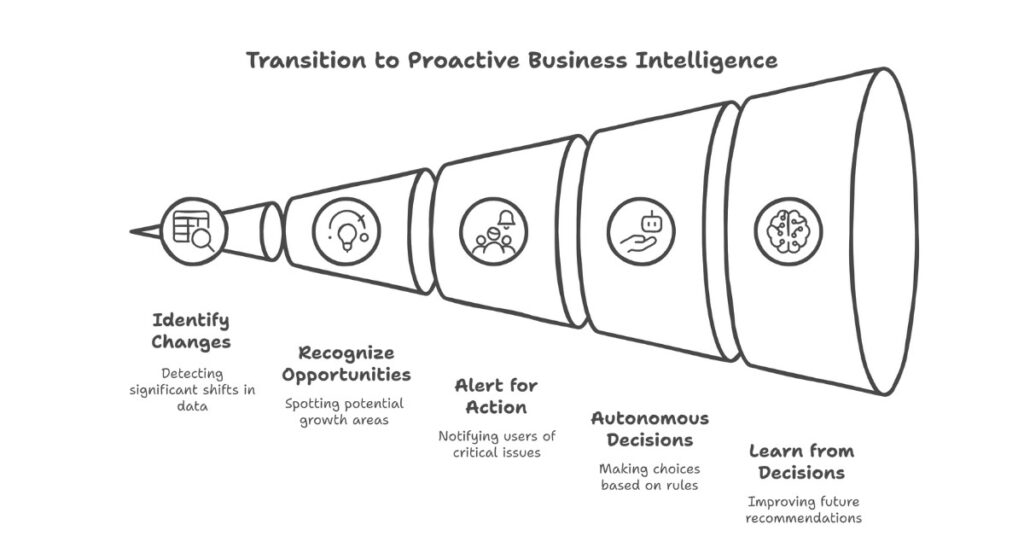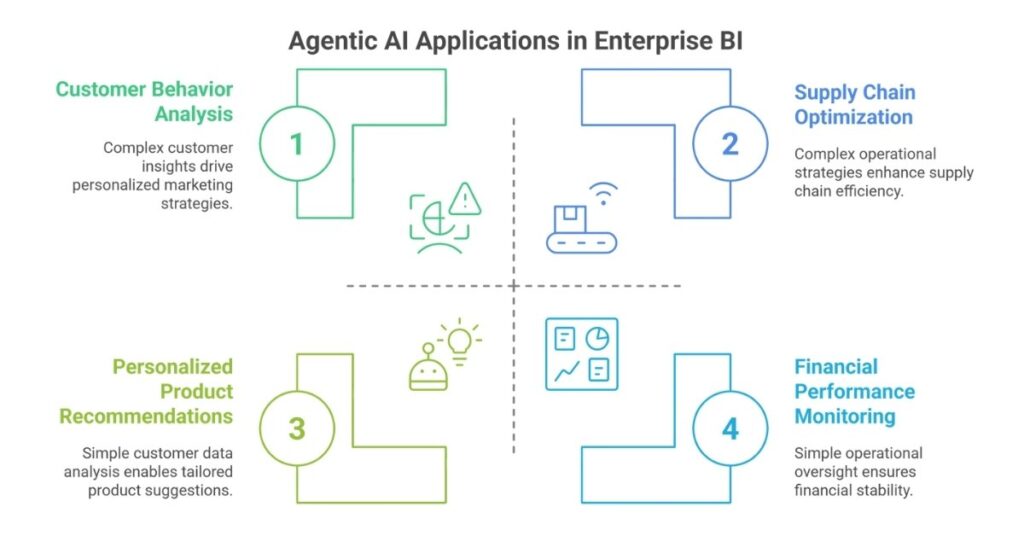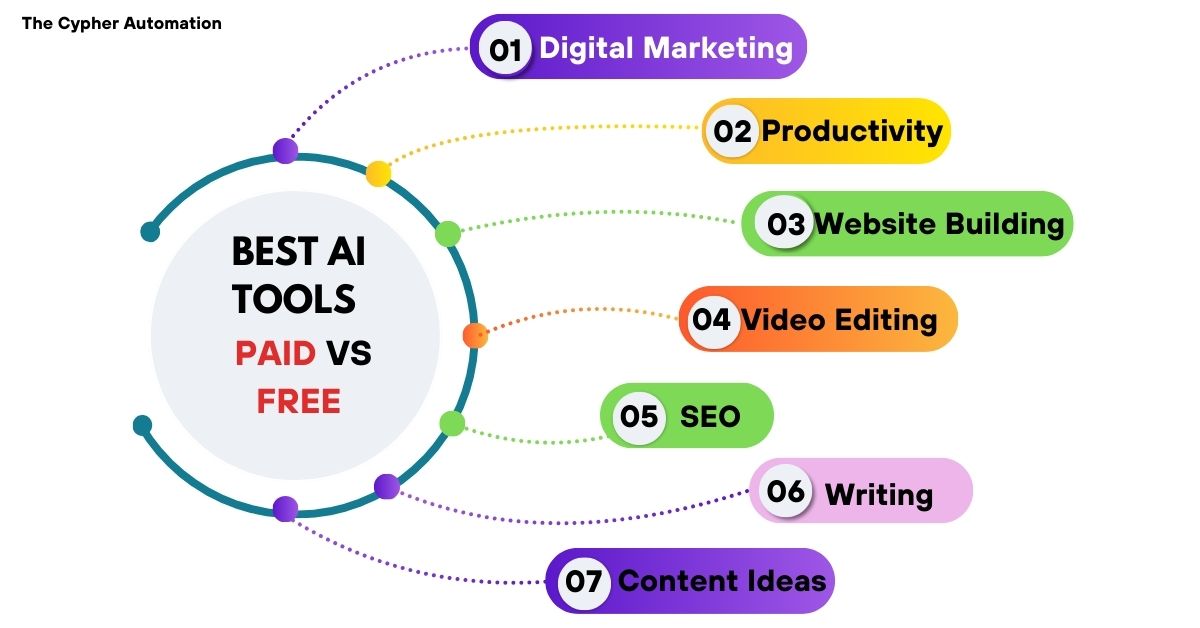The power of agentic business intelligence lies in its ability to provide predictive analytics, real-time data analysis, and autonomous decision-making capabilities. These advanced analytics tools help businesses achieve operational efficiency while reducing costs and improving accuracy. Whether you’re dealing with cross-functional data integration challenges or seeking AI-driven ROI improvements in business intelligence, agentic AI systems offer scalable solutions that grow with your business needs.

Have you ever wondered why some companies seem to make perfect decisions in agentic bi while others struggle with their data? The secret often lies in agentic business intelligence – a revolutionary generative ai approach that’s changing how businesses understand and use their information.
AI Agent represents the next evolution in data analysis, where autonomous AI systems don’t just process information but actively make decisions and take actions based on what they discover. Unlike traditional business intelligence tools that wait for human input, agentic AI in business intelligence works independently, continuously analyzing data and providing real-time insights that drive business success.
In today’s competitive agentic ai system, businesses generate massive amounts of data every day. However, many agentic analytics struggle with data overload, siloed information, and delayed decision-making processes. This is where artificial intelligence in business comes into play, offering intelligent automation that transforms raw data into actionable insights without human intervention.
What Exactly is Agentic Business Intelligence?
Agentic business intelligence combines the power of artificial intelligence in business with traditional BI tools and agentic analytics to create systems that can think, learn, and act on their own. Think of it as having a super-smart assistant that never sleeps, constantly watches your business data, and makes recommendations or even decisions without waiting for you to ask.
The word “agentic” comes from “agent” – meaning these AI-driven decision-making systems act as intelligent agents on behalf of your business. They don’t just show you charts and graphs; they understand what the data means and suggest specific actions you should take.
|| Also read What is DeepSeek and Why is Everyone Talking About It?
Key Components of Agentic Business Intelligence
Agentic AI systems in business intelligence typically include several important parts:
- Autonomous data processing capabilities that handle information without human intervention
- Predictive analytics engines that forecast future trends and outcomes
- Real-time data analysis automation tools that process information as it arrives
- Actionable insights generation that translates complex data into clear recommendations
- Data integration systems that connect information from multiple sources
How Agentic AI is Reshaping Business Intelligence
Traditional business intelligence often requires data analysts to manually create reports, run queries, and interpret results. How agentic AI and agentic ai solutions is reshaping business intelligence involves automating these processes and adding intelligent decision-making capabilities.
The Evolution from Reactive to Proactive
Old-fashioned BI tools were reactive – they only provided information when someone asked for it. Agentic AI in business intelligence is proactive, meaning it:
- Constantly monitors your business data for important changes
- Automatically identifies opportunities and risks
- AI model sends alerts when immediate action is needed
- Makes autonomous decision-making based on predefined rules
- Learns from past decisions to improve future recommendations

Breaking Down Data Silos
One of the biggest challenges businesses face is siloed data solutions. Information gets trapped in different departments, making it hard to see the complete picture. Using agentic systems to reduce data silos involves:
- Cross-functional data integration that connects information from sales, marketing, finance, and operations
- Unified data analysis that looks at your entire business as one system
- Smart data management that organizes information regardless of where it comes from
- Dynamic data environments that adapt as your business grows and changes
Benefits of Autonomous AI in BI
The benefits of autonomous AI in BI are transforming how companies operate and compete. Let’s explore the most important advantages of intelligent agent:
Speed and Efficiency Improvements
Autonomous AI systems work much faster than humans when processing large amounts of data. They can:
- Analyze thousands of data points in seconds
- Generate reports automatically without manual input
- Provide real-time business decisions with agentic AI
- Eliminate delays caused by human scheduling and availability
Enhanced Accuracy and Consistency
Human analysts can make mistakes, especially when working with complex data sets. AI-driven decision-making offers:
- Consistent analysis methods that don’t vary based on mood or fatigue
- Improving accuracy in BI through AI skills by eliminating calculation errors
- Standardized reporting formats across all business units
- Reduced risk of bias in data interpretation
Scalable Solutions for Growing Businesses
As companies expand, their data needs grow exponentially. Scalable AI solutions for growing data provide:
- Automatic adjustment to handle increasing data volumes
- Scalable AI systems that grow with your business
- Cost-effective expansion without hiring additional analysts
- Consistent performance regardless of data size
Cost Savings and ROI Improvements
Cost savings from AI in data analysis automation come from multiple sources:
- Reduced need for large analytics teams
- Faster decision-making that prevents costly delays
- AI-driven ROI improvements in business intelligence through better resource allocation
- Automated processes through multi agent system that eliminate manual work
Real-World Applications of Agentic AI Systems
Understanding agentic AI applications in enterprise BI helps illustrate the practical value of these systems. Here are some common use cases:
Customer Behavior Analysis
Agentic AI can automatically analyze customer data to:
- Predict which customers might leave your business
- Identify opportunities for improving customer retention with predictive AI
- Recommend personalized products or services
- Optimize pricing strategies based on customer behavior
Financial Performance Monitoring
AI in business operations helps with financial oversight by:
- Monitoring cash flow patterns in real-time
- Identifying unusual spending patterns that might indicate problems
- Forecasting revenue based on current trends
- Automatically generating financial reports for stakeholders
Supply Chain Optimization
Intelligent automation in supply chain management includes:
- Predicting inventory needs before stockouts occur
- Optimizing delivery routes based on real-time conditions
- Identifying supplier performance issues early
- Automating reorder processes based on demand forecasts

Marketing Campaign Performance
AI-powered forecasting helps marketing teams by:
- Predicting which campaigns will perform best
- Automatically adjusting ad spending based on performance
- Identifying the most valuable customer segments
- Optimizing content for different audience groups
Challenges Solved by Agentic AI in Analytics
Traditional business intelligence faces several common problems that challenges solved by agentic AI in analytics can address:
Information Overload
Modern businesses generate enormous amounts of data daily. Data overload solutions with AI tools help by:
- Automatically filtering important information from noise
- Prioritizing alerts based on business impact
- Summarizing complex data into digestible insights
- Focusing attention on the most critical business metrics
Delayed Decision-Making
Traditional BI tool often involves delays while analysts prepare reports and executives review them. Real-time business decisions with agentic AI eliminate these delays through:
- Continuous data monitoring that never stops watching your business
- Instant alerts when action is needed by ai solution
- Pre-approved automated responses to common situations
- Proactive decision-making that anticipates problems before they occur
Inconsistent Analysis
Different analysts might interpret the same data differently, leading to conflicting recommendations. Agentic AI solves this by:
- Using consistent analytical methods across all data
- Applying the same decision criteria every time using autonomous agent
- Eliminating personal bias from analysis
- Providing standardized reporting formats
Resource Constraints
Many businesses lack the resources to analyze all their data effectively. How businesses can leverage agentic AI to overcome resource limitations includes:
- Automating routine analysis tasks
- Scaling analysis capabilities without hiring more staff
- Providing 24/7 monitoring without additional labor costs
- Enabling small teams to handle enterprise-level data analysis
The Technology Behind Agentic Business Intelligence
Understanding the technical foundation helps appreciate how agentic AI is reshaping business intelligence in ai workflows:
Machine Learning Algorithms
Advanced analytics tools use various machine learning techniques:
- Supervised learning for prediction tasks
- Unsupervised learning for pattern discovery
- Reinforcement learning for decision optimization
- Deep learning for complex pattern recognition
Natural Language Processing
AI process automation in business intelligence often includes NLP capabilities that:
- Convert data insights into plain English explanations
- Allow users to ask questions in natural language
- Generate automated reports in readable formats
- Enable voice-activated data queries
Data Integration Technologies
Data integration systems use various technologies to connect different data sources:
- APIs that connect cloud-based applications
- Database connectors for on-premise systems
- Real-time streaming for live data feeds
- ETL (Extract, Transform, Load) processes for data preparation

Implementation Strategies for Agentic AI
Successfully implementing agentic business intelligence requires careful planning and execution:
Phase 1: Assessment and Planning
Before implementing autonomous AI systems, businesses should:
- Evaluate current data infrastructure and capabilities
- Identify specific business problems that AI can solve
- Set clear goals and success metrics
- Plan for necessary staff training and change management
Data Infrastructure Evaluation
Start by examining your current data landscape:
- Review existing data sources and quality
- Assess current analytics capabilities and gaps
- Identify technical requirements for AI implementation
- Evaluate security and compliance considerations
Problem Identification
Focus on specific challenges that agentic AI can address:
- Pinpoint inefficiencies in current reporting processes
- Identify decisions that could benefit from automation
- Look for opportunities to improve data-driven insights
- Consider areas where real-time analysis would add value
Phase 2: Pilot Implementation
Start with a small-scale pilot project that:
- Focuses on one specific business area or problem
- Uses existing data sources when possible
- Provides measurable results within a reasonable timeframe
- Allows for learning and adjustment before full deployment
Pilot Project Selection
Choose pilot projects carefully:
- Select areas with clean, accessible data
- Focus on problems with clear success metrics
- Ensure stakeholder buy-in and support
- Plan for adequate resources and timeline
Success Measurement
Define clear metrics for pilot success:
- Set baseline measurements for comparison
- Establish key performance indicators
- Plan regular check-ins and progress reviews
- Document lessons learned for future phases
Phase 3: Gradual Expansion
After proving success with the pilot, expand by:
- Adding more data sources and business areas
- Increasing the complexity of automated decisions
- Training more staff on the new systems
- Refining processes based on initial experience
Scaling Considerations
Plan for systematic expansion:
- Prioritize high-impact areas for next phases
- Ensure adequate infrastructure for increased data volume
- Develop change management strategies for broader adoption
- Create training programs for different user groups
Phase 4: Full Integration
Complete implementation involves:
- Unified data analysis across all business functions
- Full automation of routine decision-making processes
- Integration with existing business systems and workflows
- Ongoing monitoring and optimization of AI performance
Enterprise-Wide Deployment
Ensure successful full-scale implementation:
- Integrate AI systems with existing business applications
- Establish governance frameworks for AI decision-making
- Create comprehensive user training and support programs
- Develop ongoing maintenance and optimization processes
Measuring Success with Agentic Business Intelligence
Return on investment from agentic AI systems can be measured through various metrics:
Operational Efficiency Metrics
Track improvements in operational efficiency by measuring:
- Time saved on routine analysis tasks
- Reduction in manual reporting work
- Faster response times to business issues
- Decreased errors in data analysis and reporting
Time and Resource Savings
Monitor specific efficiency gains:
- Compare time spent on manual vs. automated tasks
- Track reduction in report preparation time
- Measure faster decision-making cycles
- Calculate labor cost savings from automation
Financial Performance Indicators
Monitor AI-driven ROI improvements in business intelligence through:
- Cost savings from reduced manual labor
- Increased revenue from better decision-making
- Reduced losses from early problem detection
- Improved profit margins from optimized operations
Revenue Impact Assessment
Evaluate financial benefits systematically:
- Track revenue increases attributable to AI insights
- Measure cost reductions from improved efficiency
- Calculate returns from better resource allocation
- Assess competitive advantages gained
Quality and Accuracy Measures
Assess improving accuracy in BI through AI by tracking:
- Reduction in analysis errors
- Consistency of insights across different time periods
- Accuracy of predictions compared to actual outcomes
- User satisfaction with automated insights
Performance Quality Metrics
Monitor the quality of AI-driven insights:
- Compare prediction accuracy to historical methods
- Track consistency of recommendations over time
- Measure user confidence in automated insights
- Assess decision outcomes based on AI recommendations
Future Trends in Agentic Business Intelligence
The field of agentic business intelligence continues evolving rapidly. Here are key trends to watch:
Increased Automation
Future AI-powered automation in business intelligence will include:
- More sophisticated automated decision-making
- Self-healing systems that fix their own problems
- Automated model training and optimization
- Intelligent system scaling based on demand
Advanced Automation Capabilities
Expect developments in:
- Fully autonomous business process management
- Self-optimizing analytics algorithms
- Automated integration with new data sources
- Intelligent resource allocation and scaling
Better Human-AI Collaboration
The impact of AI on traditional BI tools will focus on:
- Intuitive interfaces that make AI insights more accessible
- Better explanation of AI reasoning and recommendations
- Collaborative features that combine human intuition with AI analysis
- Customizable automation levels based on user preferences
Enhanced User Experience
Look for improvements in:
- Natural language interfaces for data queries
- Visual explanation of AI decision processes
- Personalized dashboards and recommendations
- Seamless integration with business workflows
Advanced Predictive Capabilities
AI-powered forecasting will become more sophisticated through:
- Longer-term predictions with higher accuracy
- Multi-scenario modeling and planning
- Real-time prediction updates as new data arrives
- Integration of external data sources for better context
Predictive Analytics Evolution
Anticipate advances in:
- Cross-functional predictive modeling
- Real-time scenario planning capabilities
- Integration of external market data
- Improved accuracy through ensemble methods
Industry-Specific Solutions
Agentic AI applications in enterprise BI will become more specialized:
- Healthcare-specific analytics for patient outcomes
- Financial services tools for risk management
- Manufacturing systems for quality control
- Retail analytics for customer experience optimization
Sector-Specific Developments
Watch for specialized solutions in:
- Regulatory compliance automation
- Industry-specific performance metrics
- Tailored risk assessment models
- Specialized data integration requirements
Best Practices for Implementing Agentic AI
To maximize success with agentic business intelligence, follow these proven practices:
Start with Clear Objectives
Define specific goals for how businesses can leverage agentic AI:
- Identify particular business problems to solve
- Set measurable success criteria
- Establish timelines for implementation and results
- Align AI initiatives with overall business strategy
Strategic Alignment
Ensure AI initiatives support broader goals:
- Connect AI projects to business objectives
- Involve key stakeholders in planning
- Consider long-term strategic implications
- Plan for sustainable growth and development
Ensure Data Quality
Smart data management requires:
- Clean, accurate data from reliable sources
- Consistent data formats across different systems
- Regular data validation and quality checks
- Clear data governance policies and procedures
Data Governance Framework
Establish comprehensive data management:
- Create data quality standards and procedures
- Implement regular data auditing processes
- Establish clear data ownership and responsibilities
- Develop data security and privacy protocols
Plan for Change Management
Successful implementation of autonomous AI systems involves:
- Training staff on new tools and processes
- Communicating benefits and addressing concerns
- Gradually introducing changes rather than sudden overhauls
- Providing ongoing support and resources
Organizational Readiness
Prepare your organization for AI adoption:
- Assess current skills and training needs
- Develop comprehensive training programs
- Create support systems for users
- Address cultural resistance to change
Monitor and Optimize Continuously
Continuous data monitoring should include:
- Regular assessment of AI system performance
- Ongoing refinement of algorithms and rules
- User feedback collection and implementation
- Adaptation to changing business needs and conditions
Performance Optimization
Maintain system effectiveness through:
- Regular performance reviews and adjustments
- User feedback integration
- Algorithm updates and improvements
- Adaptation to evolving business requirements
Overcoming Common Implementation Challenges
Businesses often face obstacles when implementing agentic business intelligence. Here’s how to address them:
Technical Challenges
Scalable AI systems require addressing:
- Data integration complexities across different systems
- System performance and scalability requirements
- Security and privacy concerns with automated systems
- Integration with existing business applications
Technical Solution Strategies
Address technical obstacles through:
- Comprehensive system architecture planning
- Phased integration approaches
- Robust security framework implementation
- Performance monitoring and optimization
Organizational Challenges
Reducing operational risks using AI insights involves managing:
- Resistance to change from existing staff
- Skills gaps in AI and data analysis
- Budget constraints and ROI expectations
- Coordination between different departments
People and Process Management
Handle organizational challenges by:
- Developing comprehensive change management strategies
- Investing in training and skill development
- Creating clear communication about benefits and expectations
- Establishing cross-functional collaboration frameworks
Most Strategic Challenges
Strategic business insights require considering:
- Alignment with overall business objectives
- Competitive implications of AI adoption
- Long-term sustainability of AI investments
- Ethical considerations in automated decision-making
Strategic Planning Approaches
Address strategic challenges through:
- Long-term strategic planning for AI adoption
- Competitive analysis and positioning
- Ethical framework development
- Sustainable investment strategies
The Business Case for Agentic AI
Building a compelling business case for agentic business intelligence involves demonstrating clear value:
Cost-Benefit Analysis
Calculate cost savings from AI in data analysis by comparing:
- Current costs of manual analysis and reporting
- Potential savings from automated processes
- Investment required for AI implementation
- Expected timeline for return on investment
Financial Justification Methods
Develop comprehensive financial analysis:
- Total cost of ownership calculations
- Return on investment projections
- Risk-adjusted benefit assessments
- Sensitivity analysis for different scenarios
Risk Assessment
Consider reducing operational risks using AI insights through:
- Faster identification of potential problems
- More consistent decision-making processes
- Reduced reliance on individual expertise
- Better compliance with regulatory requirements
Risk Management Benefits
Evaluate risk reduction capabilities:
- Improved early warning systems
- Consistent compliance monitoring
- Reduced operational vulnerabilities
- Enhanced business continuity planning
Competitive Advantages
AI for unified business performance analysis provides advantages like:
- Faster response to market changes
- Better customer service through predictive insights
- More efficient operations and resource utilization
- Innovation opportunities through data-driven discoveries
Competitive Positioning
Assess strategic advantages:
- Market responsiveness improvements
- Customer experience enhancements
- Operational efficiency gains
- Innovation and growth opportunities
Conclusion: The Future is Agentic
Agentic business intelligence represents a fundamental shift in how businesses understand and use their data. By combining artificial intelligence in business with traditional BI capabilities, companies can achieve autonomous decision-making that drives better results faster than ever before.
The journey toward agentic AI in business intelligence isn’t just about adopting new technology – it’s about transforming how your organization thinks about data, decisions, and competitive advantage. Autonomous AI systems provide the speed, accuracy, and scale needed to succeed in today’s fast-paced business environment.
Whether you’re dealing with data overload solutions with AI tools, seeking AI-driven ROI improvements in business intelligence, or working to implement scalable AI solutions for growing data, the key is starting with a clear vision and taking systematic steps toward implementation.
The businesses that successfully implement agentic business intelligence today will be the ones leading their industries tomorrow. Real-time data analysis, predictive analytics, and intelligent automation aren’t just nice-to-have features anymore – they’re becoming essential tools for business survival and growth.
By embracing how agentic AI is reshaping business intelligence, your organization can unlock new levels of efficiency, accuracy, and insight that drive lasting competitive advantages. The question isn’t whether agentic business intelligence will transform your industry – it’s whether you’ll be leading that transformation or following others who started sooner.
The future of business intelligence is agentic, autonomous, and available today. The only question left is: when will you start your journey toward AI-powered automation in business intelligence?









2 thoughts on “How Agentic Business Intelligence is Transforming Data Analysis”